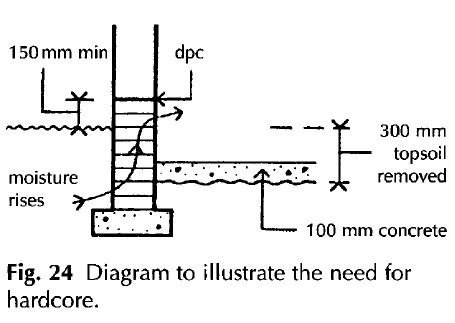When {Portland cement} was first continuously produced, towards the end of the nineteenth century, it became practical to cover the site of buildings with a layer of concrete as a solid level base for floors and as a barrier to rising damp. From the early part of the twentieth century it became accepted practice to cover the site of buildings with a layer of concrete some 100 mm thick, the concrete oversite or oversite concrete. At the time, many ground floors of houses were formed as raised timber floors on oversite concrete with the space below the floor ventilated against stagnant damp air.
With the shortage of timber that followed the Second World War, the raised timber ground floor was abandoned and the majority of ground floors were formed as solid, ground supported floors with the floor finish laid on the concrete oversite. At the time it was accepted practice to form a continuous horizontal damp-proof course, some 150 mm above ground level, in all walls with foundations in the ground.
With the removal of vegetable top soil the level of the soil inside the building would be from 100 to 300 mm below the level of the ground outside. If a layer of concrete were then laid oversite its finished level would be up to 200 mm below outside ground level and up to 350 mm below the horizontal dpc in walls. There would then be considerable likelihood of moisture rising through the foundation walls, to make the inside walls below the dpc damp, as illustrated in Fig. 24.

It would, of course, be possible to make the concrete oversite up to 450 mm thick so that its top surface was level with the dpc and so prevent damp rising into the building. But this would be unnecessarily expensive. Instead, a layer of what is known as hardcore is spread oversite, of sufficient thickness to raise the level of the top of the {concrete oversite} to that of the dpc in walls. The purpose of the hardcore is primarily to raise the level of the concrete oversite for solid, {ground} supported floors.
The layer of concrete oversite will serve as a reasonably effective barrier to damp rising from the ground by absorbing some moisture from below. The moisture retained in the concrete will tend to make solid floor finishes cold underfoot and may adversely affect timber floor finishes. During the second half of the twentieth century it became accepted practice to form a waterproof membrane under, in or over the oversite concrete as a barrier to rising damp, against the cold underfoot feel of solid floors and to protect floor finishes. Having accepted the use of a {damp-proof membrane} it was then logical to unite this barrier to damp, to the damp-proof} course in walls, by forming them at the same level or by running a vertical dpc up from the lower {membrane} to unite with the dpc in walls.
Even with the damp-proof membrane there is some appreciable transfer of heat from heated buildings through the concrete and hardcore to the cold ground below. In Approved Document L to the Building Regulations is the inclusion of provision for insulation to ground floors for the conservation of fuel and power. The requirement can be met by a layer of insulating material under the site concrete, under a floor screed or under boarded or sheet floor finishes to provide a maximum U value of 0.45 W/m2K for the floor.
The requirement to the Building Regulations for the resistance of the passage of moisture to the inside of the building through floors is met if the ground is covered with dense concrete laid on a hardcore bed and a damp-proof membrane. The concrete should be at least 100 mm thick and composed of 50 kg of cement to not more than 0.11 m3 of fine aggregate and 0.16 m3 of coarse aggregate of BS 5328 mix ST2. The hardcore bed should be of broken brick or similar inert material, fre
e from materials including water soluble sulphates in quantities which could damage the concrete. A damp-proof membrane, above or below the concrete, should ideally be continuous with the dpc in the walls.
It is practice on building sites to first build external and internal load bearing walls from the concrete foundation up to the level of the dpc, above ground, in walls. The hardcore bed and the oversite concrete are then spread and levelled within the external walls.
If the hardcore is spread over the area of the ground floor and into excavations for foundations and soft pockets of ground that have been removed and the hardcore is thoroughly consolidated by ramming, there should be very little consolidation settlement of the concrete ground supported floor slab inside walls. Where a floor slab has suffered settlement cracking, it has been due to an inadequate hardcore bed, poor filling of excavation for trenches or ground movement due to moisture changes. It has been suggested that the floor slab be cast into walls for edge support. This dubious practice, which required edge formwork support of slabs at cavities, will have the effect of promoting cracking of the slab, that may be caused by any slight consolidation settlement. Where appreciable settlement is anticipated it is best to reinforce the slab and build it into walls as a suspended reinforced concrete slab.